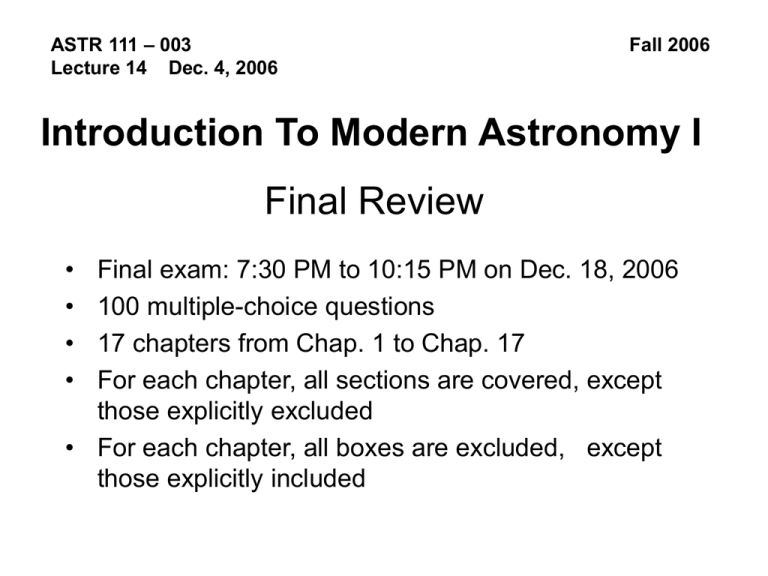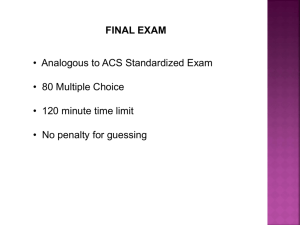ppt
advertisement

ASTR 111 – 003 Lecture 14 Dec. 4, 2006 Fall 2006 Introduction To Modern Astronomy I Final Review • • • • Final exam: 7:30 PM to 10:15 PM on Dec. 18, 2006 100 multiple-choice questions 17 chapters from Chap. 1 to Chap. 17 For each chapter, all sections are covered, except those explicitly excluded • For each chapter, all boxes are excluded, except those explicitly included • Chap. 1 --- Astronomy and the Universe (8 sections; excluding 1-2, 1-3, 1-4, 1-8) – – – – 1-1. Scientific methods, hypothesis, model, theory and laws of physics 1-5. Angular measure, angular diameter, angular size, angular distance 1-6. Powers-of-ten notation 1-7. Units of astronomical distances, AU, light year, parsec • Chap. 2 --- Known the Heavens (8 sections; excluding 2-6, 2-8; covering box 2-1 and box 2-2) – – – – – – – – 2-1. Ancient civilization, positional astronomy 2.2. Constellations 2.3. Diurnal motion of stars, Earth rotation, Annual motion of stars, Earth orbital motion, Polaris 2.4. Celestial sphere, celestial equator, celestial poles, zenith Box 2-1: celestial coordinates, right ascension, declination, 2.5. Seasons, tilt of Earth’s axis of rotation, ecliptic plane, two reasons of why summer is hotter (or winter is colder), equinoxes (vernal and autumn), solstices (summer and winter), Sun’s daily path 2-7. Timekeeping, meridian, noon, apparent solar day, mean sun, mean solar day, time zone, universal time Box 2-2. sidereal time, sidereal day • Chap. 3 --- Eclipses and the Motion of the Moon (6 sections; excluding 3-6) – – – – – 3-1. Phases of the Moon (new, waxing crescent, first quarter, waxing gibbous, full, waning gibbous, third quarter, waning crescent, and new); the cause of the phases 3-2. Synchronous rotation of Moon; synodic month (29.5 days), sidereal month (27.3 days) 3-3. Solar and lunar eclipses; causes and configurations; 3-4. Lunar eclipses; umbra, penumbra; totality 3-5. Solar eclipses; eclipse path; totality • Chap. 4 --- Gravitation and the Waltz of the Planets (8 sections; excluding 4-3) – – – – – – – 4-1. Ancient geocentric models; direct motion, retrograde motion of planets; Ptolemaic systems: cycles on cycles; deferent, epicycle 4-2. Heliocentric model of Copernicus; explanation of retrograde motion; planetary configuration; Inferior planets, elongation, evening stars, morning stars; superior planets, conjunction, opposition; synodic period, sidereal period of planets 4-4. Kepler’s three laws of planetary motion; first law of shape of orbit; second law of orbital speed, perihelion, aphelion; third law of orbital period and size (P2=a3) 4-5. Galileo’s usage of telescope; phases of Venus 4-6. Newton’s three laws of motion; first law of inertial; second law of force (F=ma); third law of action and reaction 4-7. Newton’s law on universal gravitation; orbital motion caused by gravitational force; conic sections 4-8. Tidal force; high tide, low tide; spring tide, neap tide • Chap. 5 --- The Nature of Light (9 sections, all covered; box 5-1 and box 5-5) – – – – – – – – – – – 5-1. Speed of light 5-2. Wave property of light; Electromagnetic radiation; different types of electromagnetic radiation; wavelength; frequency; color 5-3. Blackbody; Blackbody radiation Box 5-1. three temperature scales 5-4. Wien’s law on wavelength of maximum emission ; StefanBoltzmann’s law on total energy of blackbody radiation 5-5. Dual properties of light: particle and wave 5-6. Spectral lines; Kirchhoff’s laws on spectrum: continuous spectrum, emission line spectrum, and absorption line spectrum 5-7. Structure of atom Box 5-5: periodic table 5-8. Bohr’s model of atom; orbit and energy level; emission; absorption 5-9. Doppler effect; red shift and blue shift • Chap. 6 --- Optics and Telescopes (7 sections; excluding 6-4, 6-6) – – – – – 6-1. Refraction; Refraction telescope; focal point; light-gathering power; magnifying power 6-2. Reflection telescope; objective mirror; 6-3. Angular resolution; diffraction limit; seeing 6-5. Spectrograph; grating 6-7. Telescope in orbit; Optical window, radio window; advantages in orbit • Chap. 7 --- Comparative Planetology I: Our Solar System (8 sections, excluding 7-3, 7-8) – – – – – – 7-1. Solar system; Terrestrial planets versus Jovian planets in size, mass, density and composition 7-2. Seven large satellites 7-4. Chemical composition; Light elements, heavy elements; Ices in the solar system 7-5. Asteroids; comets 7-6. Impact craters; meteoroids; geologic activity; internal heat 7-7. Magnetic field of planets; core of conducting fluid; dynamo • Chap. 8 --- Comparative Planetology II: the Origin of Our Solar System (6 sections, excluding 8-6) – – – – – 8-1. Requirements of solar system model 8-2. Abundance of Chemical elements; Origins of H and He, and heavy elements; interstellar medium 8-3. Solar system age; radioactive age-dating 8-4. Solar nebula hypothesis; protosun 8-5. Protoplanetary disk; condensation temperature; ice particles; planetesimals; protoplanets • Chap. 9 --- The Living Earth (all 7 sections) – – – – – – – 9-1. Active Earth; Three sources of energy; Greenhouse effect; Greenhouse gas 9-2. Earth’s interior structure; crust, mantle, and core (outer and inner cores); seismic waves 9-3. Plate tectonics; Pangaea; Asthenosphere, lithosphere; Seafloor spreading, subduction; Earthquake 9-4. Earth’s magnetosphere; solar wind 9-5. Earth’s atmosphere; Composition (Nitrogen and Oxygen); Effects of living organism; Photosynthesis and oxygen 9-6. Temperature profiles; troposphere and convection; stratosphere and ozone 9-7. Earth’s biosphere; Global warming; Ozone hole • Chap. 10 --- Our Barren Moon (5 sections, excluding 10-4) – – – – 10-1: Surface. Craters, Terrae, Maria 10-2: Manned exploration 10-3: Interior. No plate tectonics 10-5: Formation. Collision-ejection theory. Tidal force • Chap. 11 --- Mercury (4 sections) – – – – 11-1: Difficulty in observing Mercury 11-2: Rotation. 3-2 spin-orbit coupling 11-3: Surface. No plate tectonics. No atmosphere 11-4: Interior. Large core • Chap. 12 --- Venus (6 sections) – – – – – – 12-1: Morning Star, Evening Star. Elongation. 12-2: Retrograde rotation of Venus 12-3: Thick atmosphere. High temperature. Sulfuric acid clouds 12-4: Hot-spot volcanism. Clouds. 12-5: Climate evolution. Venus versus Earth. Recycle of greenhouse gases. Runaway greenhouse effect. 12-6: Surface (Volcanism) and Interior (no platetectonics) • Chap. 13 --- Mars (8 sections, excluding 13-6, 13-7 and 13-8) – – – – – 13-1: Best observation of Mars, opposition. 13-2: Illusion of seasonal color changes. Canal illusion. 13-3: Surface. Craters. Volcanoes, Olympus Mons. Dichotomy (southern highlands versus northern lowlands) 13-4: Water on Mars. Polar ice caps. Frozen water 13-5: Climate evolution. Atmosphere. Runaway icehouse effect. Frozen water. Locked carbon dioxide • Chap. 14 --- Jupiter and Saturn (12 sections, excluding 14-5, 14-8, 14-11, 14-12) – – – – – – – – 14-1: Orbital motion, opposition. Cloud-top. Dark belts. Light Zones. Great Red Spot 14-2: Differential rotation of Jupiter and Saturn 14-3: Atmosphere. Composition (hydrogen and helium). Saturn’s helium deficiency. Great Red Spot. 14-4: Energy of atmospheric motion; Internal energy source. Temperature gradient. 14-6: Oblateness. Core. Internal structure of Jupiter and Saturn 14-7: Magnetic field. Liquid metallic hydrogen 14-9: Saturn’s rings. Rings and gaps. 14-10: Ring’s composition. Ring particles. Roche Limit. • Chap. 15 --- Satellites of Jupiter and Saturn (10 sections, excluding 15-5, 15-7, 15-10) – – – – – – – 15-1: Jupiter’s Galilean satellites, Io, Europe, Ganymede, Callisto. Synchronous rotations 15-2: Relative density and composition of the four Galilean satellites 15-3: Origin of the Galilean satellites. Jovian nebula. 15-4: Io. Volcanoes. Tidal heating 15-6: Europe. World of water ice. Geological activity. Tidal heating 15-8: Titan. Atmosphere and appearance of Titan 15-9: Jupiter’s small moons; Capture of asteroids • Chap. 16 --- Uranus, Neptune, and Pluto (9 sections, excluding 16-5, 16-6, 16-7, 16-8) – – – – – 16-1: Chance discovery of Uranus; Predicted discovery of Neptune 16-2: Uranus’s atmosphere. High concentration of Methane, color. Unusual rotation axis. Exaggerated seasonal change 16-3: Neptune’s atmosphere. Dynamic atmosphere. Great Dark Spot. Internal heat. Gravitational contracting. 16-4: Internal structure of Uranus and Neptune (rocky core, liquid water/ammonia, liquid hydrogen/helium, atmosphere) 16-9: Pluto. Charon. Kuiper Belt. (Pluto not a planet any more) • Chap. 17 --- asteroids and comets (9 sections) – – – – – – – – – 17-1: Discovery of asteroids. “Missing planet” 17-2: Asteroid belt. Formation. Gravitational effect of Jupiter. Planetesimals failing to form a planet 17-3: Asteroid’s shape and composition. “rubble pile” 17-4: Trojan asteroids. Lagrange points. NEO. Iridium layer. Dinosaurs extinction 17-5: Meteoroid, Meteor. Meteorite. 17-6: Meteorite’s trace on solar system formation 17-7: Comet. Nucleus. Coma. Hydrogen envelope. Dust tail. Ion tail. Radiation pressure. Solar wind 17-8: Comet origin. Kuiper Belt. Oort cloud 17-9: Meteoritic swarm. Meteor shower





